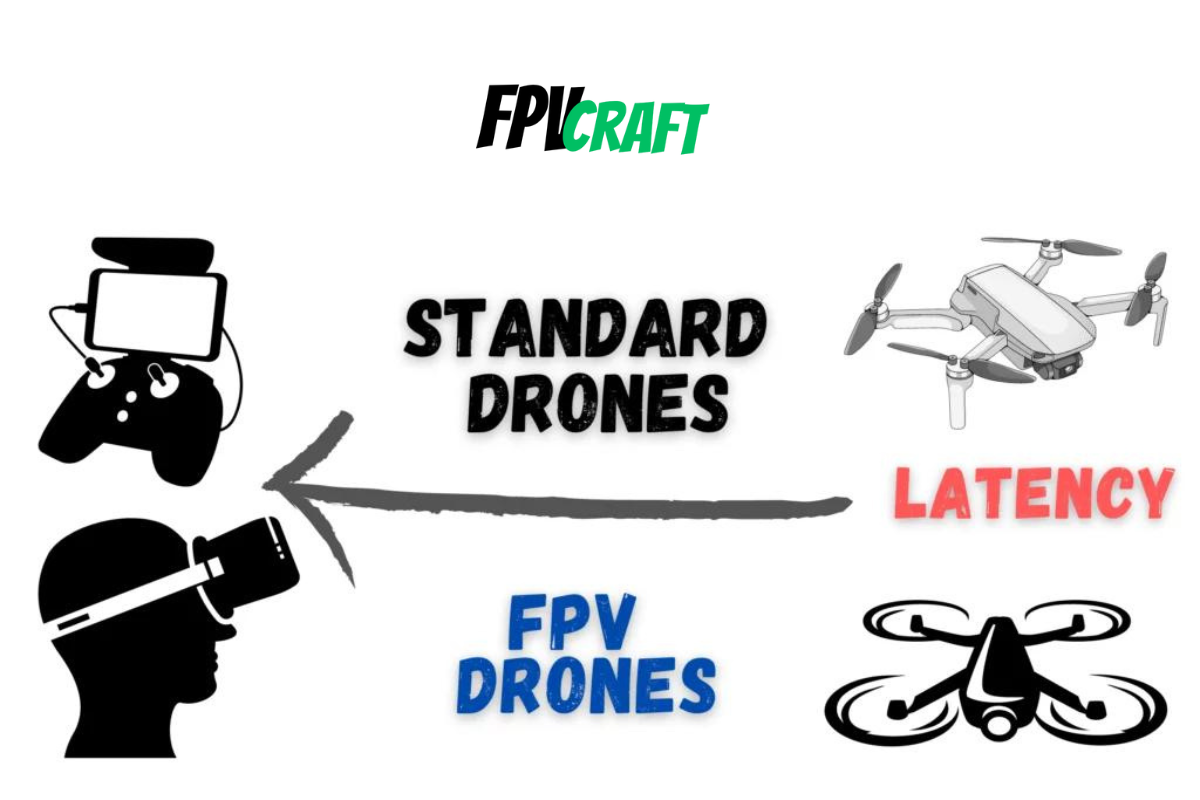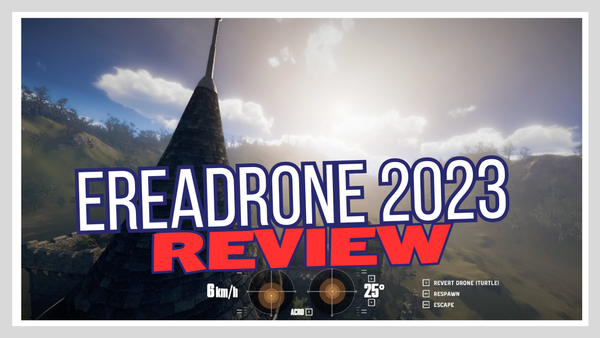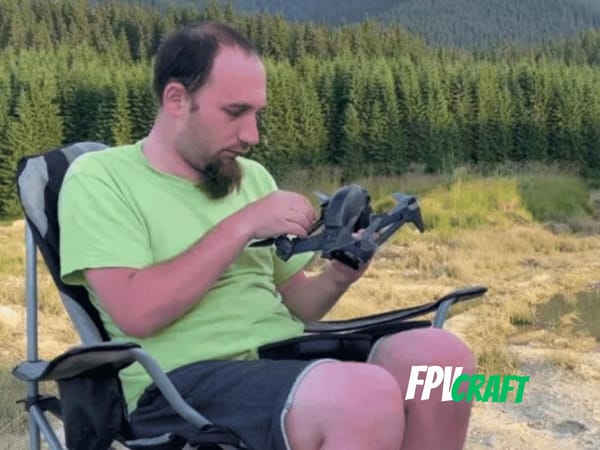Standard GPS Drones vs. FPV Drones Video Latency
There's a huge difference in video latency between standard GPS drones and FPV drones. So here we are, explaining everything in detail.

When we fly a drone, the video signal sent from the drone VTX module and received by either the remote controller or goggles, in the case of FPV drones, may have little latency.
But this video latency may differ from standard GPS drones to FPV drones, and here’s what we know.
An FPV drone video has a bit of latency from the moment the video camera collects the image and the video transmitter module encodes, compresses, and sends it until it is received by goggles, of about 30-40 milliseconds for most digital transmissions, and analog can go down to even five milliseconds. A standard GPS drone has the lowest video latency of about 120 milliseconds.
In this topic, I want to share with you everything is to know about the latency difference between the standard GPS drone and the FPV drones.
Standard GPS drone latency – what do we know
To understand the latency on a standard drone, firstly, we must understand how this drone functions in transmitting a live image and receiving a radio link.
Let’s take a high-end consumer drone, the DJI Mavic 3 Pro, with the ultimate controller, the DJI RC Pro, which is a very expensive combination. But this drone has the O3+ VTX module.
The O3+ is the latest and most advanced video module found in a standard drone that transmits digital images to the remote controller.
In this specific case, the video module not only transmits the live image to the remote controller but also receives radio input from the remote controller. It’s like a 2-way road.
The DJI Mavic 3 with the DJI RC Pro has the lowest video latency of 120 milliseconds, which, in terms of standard drones, is excellent, but in terms of FPV drones (to compare), it is exaggeratedly much.
Video modules of standard drones are not designed for extremely low latency. The drone has to record at high resolution and, simultaneously, encode, process, compress and transmit the image and also receive radio input; the remote controller app (software) + the hardware has to receive and decode/decompress the image obtained and display it.
All these functions contribute to adding to the latency of the drone, and that’s why more expensive drones have the better computing power to work faster.
But leaving the DJI Mavic 3 Pro with DJI RC Pro aside, most common drones have a video latency of about 200 milliseconds.
Can standard GPS drones be used as FPVs?
No. There are ways you can display the live image on FPV goggles, but latency is way too high to be flown as such.
A gamer who plays online shooters may understand well: You can’t play if you have 200 millisecond latency, but you can do it well with 25 milliseconds or less.
Moreover, these drones are not designed to work as FPV drones. The best you can do is mime with a headset in sport mode, but an FPV drone flown in acro mode doesn’t have any internal sensors active and will have different inputs and flight characteristics.
That is without forgetting the latency of a standard drone and the inability of this to send the video feed directly to a receiver.
I recommend you have a look over the following article:
Read More: Why FPV Drones Fly Differently than Standard Drones?
FPV drone latency – what do we know?
With FPV drones, there’s another story.
We have digital transmission and analog transmission.
You will have to choose between high-quality video transmission and lower latency.
Digital transmission has evolved a lot in the past few years, and the latency has been reduced considerably, getting close to the analog video latency.
To understand better how the FPV system works, generally, the video transmitted by the VTX module is received directly by goggles, and the remote controller sends signals, generally to a radio receiver installed separately on an FPV drone.
With DJI VTX modules on FPV drones, you are also able to receive radio links on the same module from a DJI FPV Remote Controller, which is the only one compatible.
In this specific case, we talk about the DJI FPV and DJI Avata drone, where the same video module will both transmit images to the goggles and receive the pilot input from the remote controller.
These FPV video modules are specifically designed to transmit on high power at low latency, hence the reason why FPV drones’ video latency is so low.
Let’s have a look at the DJI Avata, shall we?

The video transmitted by the DJI Avata to the DJI FPV Goggles V2 on 810p at 120 frames per second can get as low as 28 milliseconds.
That is a lot of processing and transmission power for the Avata VTX module to be able to do that as compared to a standard drone.
But please remember that this is a digital transmission. A few years back, you would have to deal with digital video latencies of 80+ milliseconds.
A digital transmission will have to encode and compress the image before it is transmitted, which also requires a lot of computing power for this function, ultimately adding a slight latency when compared to analog transmission.
With Analog (and HD Zero) transmission, that’s a different story.
There are only a handful of digital video modules, most of them manufactured by DJI, but in the case of an analog video module, those are plenty manufactured by many corporations and companies around the world.
A low-latency analog camera doesn’t process the image much and transmits raw feed directly to the analog receiver. When we reduce or remove the encoding and compressing time, the latency can get as low as a few milliseconds.
I will recommend you watch the following video from Joshua Bardwell:
Latency vs. image quality on FPV drone – which to choose?
We basically have to choose between a digital system and an analog system in this situation.
Unless you want the lowest latency on your FPV drone for racing and extreme freestyle, the digital video latency is not even much more noticeable than the analog latency.
But keep in mind that a digital video module is a lot more expensive than an analog one.
However, we also have the HD Zero, which is still digital, but the image is not encoded. However, this is yet another story, as you will also need an HD Zero receiver module installed on compatible goggles.
Can we reduce latency on standard GPS drones?
There are a few tricks that may help you slightly reduce the latency on standard GPS drones and even on some FPV drones, and most of them are just common checkpoints to meet.
- Flying a drone in an interference-free zone not only helps a drone fly farther, but the latency will be lower than flying in an area with a lot of WiFi interference.
- Flying short range: when you fly farther, you slightly increase latency. Not by a lot, but it will be noticeable at a point, especially when the video signal is getting weaker.
- Installing different radio antennas on your remote controller may help extend the range and lower the latency of some standard GPS drones.
- Changing the remote controller, and here we talk about drones with the DJI RC-N1 remote controller, and if this can be upgraded to DJI RC or DJI RC Pro, you will have lower latency on your standard drone – but never as low as an FPV drone, even digital.
What can influence video latency on a drone?
- The VTX module it has installed is the main reason that can influence the video latency of a drone, wherever GPS standard drone or FPV drone, analog or digital.
- Also, the receiver contributes a lot to the latency of a video signal from either a standard or FPV drone.
- How much the drone has to encode and compress the video before transmitting it and how much for a receiver it takes to decompress and display the video are contributory factors influencing digital video latency on a drone.
- The transmitting power of a module and operating frequency can also contribute to the video latency of a drone. For instance, 25mW will have slightly higher latency than 200mW VTX.
- And there could be other factors as well, such as the goggles on FPV drones, the video receiver antennas, the VTX temperature (hot is bad), and the signal strength.
Although the video is transmitted from the drone to the receiver at the speed of light, typically, how far the drone is from us, contradictory to what I’ve mentioned above, wouldn’t matter much for adding the latency of the video.
Still, once the signal is low, we have dropping frames, which gives the impression of a massive lag, and that’s how digital video latency is introduced on long-range flights.
» READ MORE: How Long Can an FPV Drone Fly?




